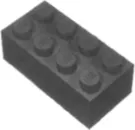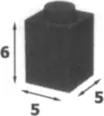Introduction
Before you enter the world of LEGO robotics, we want to be sure you know and understand some basic geometric properties of the LEGO bricks and beams. Don’t worry; we’re not going to test you with complex equations or trigonometry. We’ll just discuss some very simple concepts and explain some terminology that will make assembling actual systems easier from the very beginning.
You will discover which units LEGO builders use to express sizes, the proportions of the bricks and beams, and how this affects the way you can combine them with different orientations into a solid structure.
In the past few years, there has been a shift from building with TECHNIC bricks and beams to building with studless beams, pins, and connectors. After we introduce some basic concepts, you will be exposed to these new ideas and see examples of how you can use studless building.
We encourage you to try to reproduce all the examples we show in this chapter with your own LEGO parts. If for any reason, you feel that what we present is too complex or boring, don’t force yourself to read it. Skip the chapter and go to another one. You can always come back and use this chapter as a sort of glossary whenever you need it.
Expressing Sizes and Units
LEGO builders usually express the size of LEGO parts with three numbers, representing width, length, and height, in that order. The standard way to use LEGO bricks is “studs up.” When expressing sizes, we always refer to this orientation, even when we are using the bricks upside down or rotating them in 3D space.
Height is the simplest property to identify. It’s the vertical distance between the top and bottom of the basic brick. Width, by convention, is the shorter of the two dimensions which lie on the horizontal plane (length is the other one). Both width and length are expressed in terms of studs, also called LEGO units. Knowing this, we can describe the measurements of the most traditional brick, the one whose first appearance dates back to 1949, which is 2 × 4 × 1 (see Figure 1.1).
LEGO bricks, although their measurements are not expressed as such, are based on the metric system: A stud’s width corresponds to 8 mm and the height of a brick (minus the stud) to 9.6 mm. These figures are not important to remember. What’s important is that they do not have equal values, meaning you need two different units to refer to length and height. Their ratio is even more important: Dividing 9.6 by 8 you get 1.2 (the vertical unit corresponds to 1.2 times the horizontal one). This ratio is easier to remember if stated as a proportion between whole numbers: It is equivalent to 6:5. Figure 1.2 shows the smallest LEGO brick, described in LEGO units as a 1 × 1 × 1 brick. For the reasons explained previously, this LEGO “cube” is not a cube at all.
The LEGO system includes a class of components whose height is one-third of a brick. The most important element of this class is the plate, which comes in a huge variety of rectangular sizes, and in some special shapes too. If you stack three plates, you get the height of a standard brick (see Figure 1.3).
The advent of studless building has thrown a wrench into our understanding and use of the classic brick-and-plate-construction approaches. The new studless components provide a different way to construct LEGO models. The jury is still out regarding which method is better or more preferred—there are proponents on both sides of the fence with this. Figure 1.4 shows the traditional plates and bricks next to a newer TECHNIC beam and a set of three liftarms that are stacked, all to provide some reference on size. You will notice that their stacked heights are not compatible across the studded (left) and studless (right) parts.
The one thing that is undeniable is that LEGO has made a significant shift with its TECHNIC and MINDSTORMS lines toward studless components. If you are a die-hard studded builder, you are encouraged to take the plunge and try building studless. Many found the change in approach a challenge at first, but use it almost exclusively now. Studless building offers countless options for connectivity and even allows for building at odd angles that was difficult to accomplish with traditional beams.
Squaring the LEGO World: Vertical Bracing
Why do we care about all these relationships? To answer this, we must travel back to the late 1970s when the LEGO TECHNIC line was created. Up to that time, LEGO was designed and used to build things made of horizontal layers: Bricks and plates integrate pretty well when stacked together. Every child soon learns that three plates count for a brick, and this is all they need to know. But in 1977, LEGO decided to introduce a new line of products targeting an older audience: LEGO TECHNIC. It turned the common 1 × N brick holes into what ...








